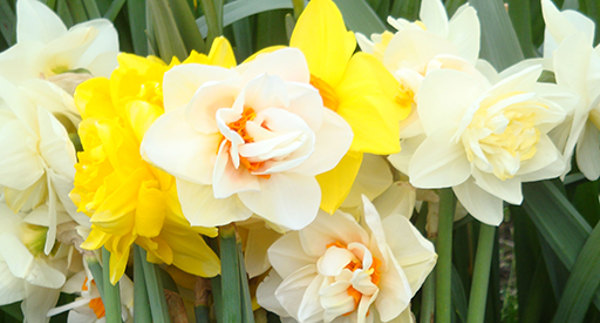
Nothing quite says spring has arrived like Daffodil’s do. These well-known garden treasures come in a wide range of shapes, sizes, colours and types. The days of only bright yellow Daffodils being available are gone; now you can find numerous shades of white, orange, lemon, cream and ivory. There is bound to be a Daffodil to suit most gardens, and they’re almost fool proof. Ideal for picking for the vase as they last for over a week.
3 steps to planting daffodils
prepare
Growing Daffodil’s is easy, generally all they need is a good, fertile, free-draining soil and plenty of sun. Choose a well-drained site for your Daffodil’s as they loathe wet feet. They thrive in pots & containers too, so you have lots of options about where you can place and plant your bulbs. Daffodils need plenty of sun to flower, but will flower well if planted under deciduous trees, as the sunlight will be able to get through the branches when the tree has no leaves.
The main types of Daffodils are Cups, Miniatures, Ruffled and Trumpets. Favourite varieties to look out for are Accent, Bambi, Erlicheer, Manley, Moneymaker, St lssey, Soleil d’Or, Taurus and Tonga.
Like building a house a good foundation is the key to success in your garden. The better the soil, the better your plants will grow. If you are starting with an existing garden bed dig in organic matter like Tui Sheep Pellets and Tui Compost to your soil. Then you can add a layer of Tui Bulb Mix. To help with flowering, use a side-dressing at planting time of Tui Bulb Food. Check individual planting instructions. Plant each bulb twice the width of the bulb. Always water well after planting.
PLANT
Daffodil bulbs are available in garden centres from early March and can be planted up until May early June. Have your early flowering varieties such as Paper Whites and Erlicheer in the ground in by Easter. The best times to plant are early in the morning, or late in the day so the plants aren't exposed to the hot sun straight away. Always water plants well before and after planting.
Directions for planting in garden beds
- Water plants thoroughly before planting and allow to drain.
- Dig a hole, approximately twice the depth and width of the root ball of your plant.
- Gently loosen the root ball of your plant and position the plant in the centre of the hole.
- Fill in with Tui Bulb Mix.
- Press soil gently around the base of the plant.
- Water your plant well and continue to water regularly.
Directions for potting plants
- Water plants thoroughly before potting and allow to drain.
- Half fill your container with Tui Bulb Mix.
- Gently take the plant from the current container, loosen the root ball and remove any loose or dead pant material and roots.
- Position the plant in the centre of the new container and fill with Tui Bulb Mix up to 3cm from the top.
- Gently firm mix around the base of the plant. The mix should be at the same level on the plant as it was in the previous container.
- Water your plant well and continue to water regularly.
nourish
Feed your plants and they will reward you. Replenishing the nutrients used by your plants ensures your plants grow to their full potential. Feed your Daffodils with Tui Bulb Food or use an all-purpose variety such as Tui NovaTec® Premium Fertiliser. Fertilise when planting, when the first leaves and buds appear and then again straight after flowering.
A well-watered, well-nourished garden will have a better chance of keeping insect pests and diseases at bay. While your Daffodils are growing regularly apply a dose of Tui Organic Seaweed Plant Tonic to give them a welcome boost.
Once picked, Daffodils can survive with no water for a day or two.
Daffodil juice is toxic if consumed in large amounts, so it’s advisable if you are going to be picking large numbers to wear gloves.
Removing dead flowers from Daffodils is a good way to encourage new bulbs.